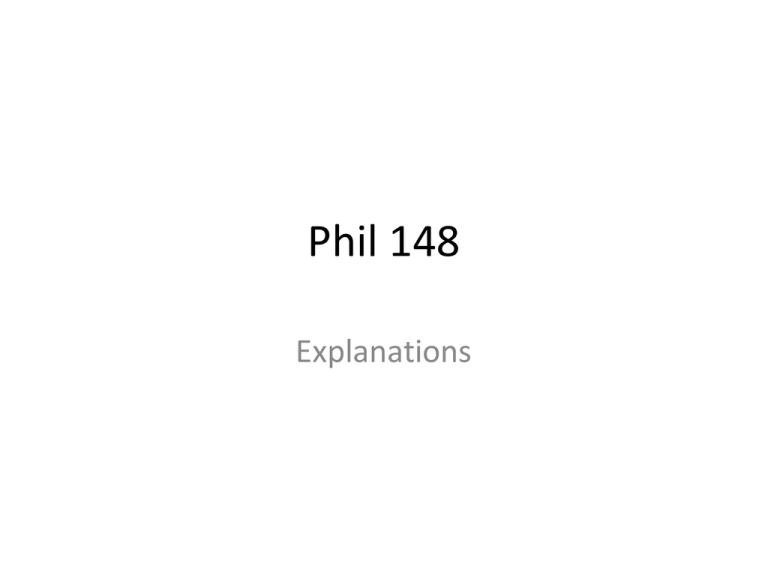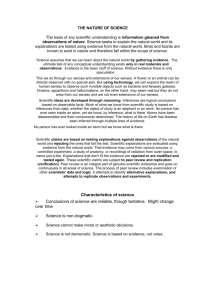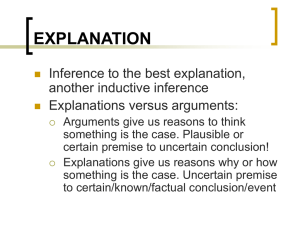Explanations
advertisement

Phil 148 Explanations Inferences to the Best Explanation. • IBE is also known as ‘abductive reasoning’ • It is the kind of reasoning (not deduction) that Sherlock Holmes is really famous for. • A hypothesis gains support if it accords with our background beliefs and works better than any competing explanation. • On the next slide is a set of standards by which we evaluate IBEs. Many of these standards will be reused on other aspects of inductive reasoning. The “Hat Trick” • Witness a television adaptation of a part of the Arthur Conan Doyle story “The Blue Carbuncle” • http://www.youtube.com/watch?v=1bCS4icTr H0 Standards for IBE (or any explanation for that matter) A good IBE: …makes sense of what it seeks to explain. …is deep, that is, the explanation itself does not need further explanation. …is powerful, that is, the explanation could be used over a wide range of cases. …is falsifiable, that is, the explanation can be wrong. Explanations that can’t be wrong in principle are vacuous. …is modest, or does not claim any more than it has to. …is simpler than competing explanations with equal explanatory force. …is conservative, that is, forces us to revise or give up as few of our previously held beliefs as possible. Consistency • First off, any explanation must be consistent with what it seeks to explain. It should fit all of the relevant evidence. Depth of Explanation • An explanation is shallow to the extent that it itself requires explanation. • Book: “Why did the police raid your house?” Because they suspected you. Power of Explanations • An explanation is powerful to the extent that it explains more than just a few special cases. • Einstein’s theories replaced Newton’s theories because they could explain a wider range of observations. • Be careful though, when a theory (like the indefinite discrete ghosts theory) explains too much, because in so doing, it fails to explain why the observations came out the way they did as opposed to any other way. Falsifiability of Explanations • A theory is falsifiable if it is subject to disconfirmation by evidence. • Non-falsifiable theories are sometimes called “self-sealing”, e.g. “The reason you don’t believe that aliens have taken over all life is that they have gotten to your brain processes!” • DO NOT confuse ‘falsifiable’ with ‘false’ • See Peter Woit’s “Not Even Wrong” for an account of how string theory is not falsifiable Modesty in Explanations • An explanation or theory is modest if it does not claim more than it needs to claim in order to do the explaining. • Occam’s razor, though often taken to be a statement of simplicity in theory, is really a statement of modesty. ("entities must not be multiplied beyond necessity" (entia non sunt multiplicanda praeter necessitatem)) Simplicity in Explanation • Simplicity is something of a tie-breaker. • There are many simple theories that fail other criteria (like the indefinite discreet ghosts theory). • Simplicity is more of an aesthetic concern that can apply when two theories explain the phenomena equally well. Conservatism in Explanation • That we have believed a particular thing for a long time is no reason to continue believing it, so conservatism is never the most important criteria. • However, we should not give up our best theories lightly. • An explanation is conservative to the extent that it does not require the overturning of existing and accepted theory. Book Feature • The Structure of Scientific Revolutions, by Thomas Kuhn • Concerns just how and why we hold onto conservatism in explanation • A truly revolutionary look at science “Let the Facts Decide” • Arguments involving underdetermination attempt to show that there is no reason for belief regarding some theory because it is underdetermined by the evidence. Since the evidence does not show that the theory is the uniquely true hypothesis, there is no reason to believe it rather than some equally supported rival. • Because arguments involving underdetermination involve both a claim about what the evidence is and that such evidence underdetermines a theory, it is often useful to separate these two claims within the underdetermination argument as follows: – All the evidence of a certain type underdetermines which of several rival theories is correct. – Only evidence of that type is relevant to believing one of these theories. – Therefore, there is no evidence for believing one among the rival theories. • The first premise makes the claim that a theory is underdetermined. The second says that rational decision (i.e. using available evidence) depends upon evidence that underdetermines the theory.











